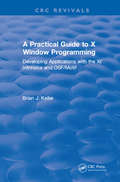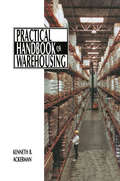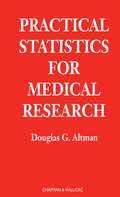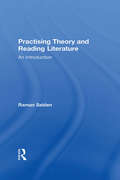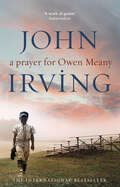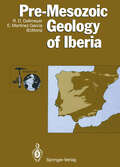- Table View
- List View
The Practical Application of Medical and Dental Hypnosis
by Milton H. Erickson Seymour Hershman Irving I. Secter"During the past several years there have been ever-increasing numbers of physicians, dentists, and psychologists interested in hypnosis, both therapeutic and investigative. Reliable sources of clinical information and instruction were practically non-existent except for a few scattered individuals. To meet this need, to interest universities, and to stimulate medical and dental schools to an awareness of the importance of teaching clinical hypnosis, a group of experienced clinicians competent in teaching were formed. Throughout the United States, under the auspices of various professional societies and universities, this group conducted seminars on hypnosis."This book is compiled from the tape recordings of dozens of those seminars, and thus it contains the material as it was presented, with all the simplicity, directness, and effectiveness of the classroom presentation."It is no more, no less, than a comprehensive presentation of the material upon which thousands of clinicians throughout the United States have based the initiation and development of their successful clinical use of hypnosis."-Milton H. Erickson, M.D. (1961)
The Practical Application of Medical and Dental Hypnosis
by Milton H. Erickson Seymour Hershman Irving I. Secter"During the past several years there have been ever-increasing numbers of physicians, dentists, and psychologists interested in hypnosis, both therapeutic and investigative. Reliable sources of clinical information and instruction were practically non-existent except for a few scattered individuals. To meet this need, to interest universities, and to stimulate medical and dental schools to an awareness of the importance of teaching clinical hypnosis, a group of experienced clinicians competent in teaching were formed. Throughout the United States, under the auspices of various professional societies and universities, this group conducted seminars on hypnosis."This book is compiled from the tape recordings of dozens of those seminars, and thus it contains the material as it was presented, with all the simplicity, directness, and effectiveness of the classroom presentation."It is no more, no less, than a comprehensive presentation of the material upon which thousands of clinicians throughout the United States have based the initiation and development of their successful clinical use of hypnosis."-Milton H. Erickson, M.D. (1961)
Practical Applications of Fiberoptics in Critical Care Monitoring
by Frank R. Lewis Ulrich J. PfeifferStimulating and provocative work with fiberoptic technology is reported in this volume. Invasive fiberoptic reflectometry has only been used up to now for monitoring intravascular oxygen saturation. These contributions examine how this technique can be clinically applied to measure other parameters in the critically ill patient. Methodological aspects are discussed, but the main focus is on clinical value and application. The authors look at measurements that can be evaluated using a flowdirected fiberoptic pulmonary artery catheter and an arterial fiberoptic thermodulution catheter. These measurements deal with oxygen saturation, intrathoracic and total blood volume, indocyanine green dye liver function, and extravascular lung water. Considering the advanced state of the technology and the innovative physiologic concepts presented here, this book lays the foundation for a new, integrated monitoring system of cardiopulmonary physiology.
Practical Echocardiography in the Adult: with Doppler and color-Doppler flow imaging (Developments in Cardiovascular Medicine #109)
by J.P.M HamerSince the introduction of ultrasound in cardiology in the mid fifties, echocar diography has continued to grow and has finally become, in particular after the introduction of Doppler modalities, the working horse of the cardiologist. Although many books have been written on this subject Dr. Hamer's book is a very valuable contribution, as it provides, in particular information for practicing clinicians and technicians. Clearly written and nicely illustrated, this book is a must for those interested in this field. C.A. Visser Professor of Echocardiology Preface Trans-thoracic echocardiography is a patient friendly technique without pain or discomfort. It is harmless and the patient can relax during the examination. With these advantages in mind there is hardly any technique in cardiology that can provide so much valuable information about the function of the heart. If Doppler and color Doppler, also painless techniques, are added to echo cardiography additional information about blood flow velocities, insufficiency and stenosis of valves, detection of shunts etc. is obtainable. Less patient friendly but - if selectively used - very informative, is trans esophageal (color Doppler) echocardiography.
A Practical Guide To X Window Programming: Developing Applications with the XT Intrinsics and OSF/Motif
by Brian J. KellerA Practical Guide to X Window Programming is a basic guide that takes readers step by step through developing applications using X-Windows. The book covers the Xt Intrinsics portion of the X-Window system in detail and discusses the MIT Athena and OSF/Motif Widget Sets that are used in many of the examples. Topics covered include C programming fundamentals, text handling using X, fonts, event handling in Xt, extending the Widget Sets (building on Field Editor Widget), designing and constructing an application, building menus, printing help, OSF/Motif (including the window arranger) and interclient communication. Three extensive appendices are included: Widgets, Classing, and Exported Functions; Quick Xt Reference Guide (X11R4); and Quick Guide to OSF/Motif Widgets. Any applications designer interested in developing applications with Xt will find this book a valuable and enlightening resource.
A Practical Guide To X Window Programming: Developing Applications with the XT Intrinsics and OSF/Motif
by Brian J. KellerA Practical Guide to X Window Programming is a basic guide that takes readers step by step through developing applications using X-Windows. The book covers the Xt Intrinsics portion of the X-Window system in detail and discusses the MIT Athena and OSF/Motif Widget Sets that are used in many of the examples. Topics covered include C programming fundamentals, text handling using X, fonts, event handling in Xt, extending the Widget Sets (building on Field Editor Widget), designing and constructing an application, building menus, printing help, OSF/Motif (including the window arranger) and interclient communication. Three extensive appendices are included: Widgets, Classing, and Exported Functions; Quick Xt Reference Guide (X11R4); and Quick Guide to OSF/Motif Widgets. Any applications designer interested in developing applications with Xt will find this book a valuable and enlightening resource.
Practical Handbook of Agricultural Science (Routledge Revivals)
by A. A. HansonFirst published in 1990, this new handy guide book is a "quick reference" to a variety of topics pertaining to soils, and to the production and use of plants and animals. Emphasis has been devoted to basic considerations in plant adaptation, soils, seeds, major field crops, and selected aspects of animal science. A reasonable amount of background information on most topics selected for inclusion is furnished, providing the reader with critical information on the subject matter presented, in the absence of access to other source materials. Attention has been given to the inclusion of both common and scientific plant names, various conversion tables, tabular material used in the interpretation of certain statistical tests, and a glossary, albeit abridged, of terms encountered in the improvement and management of soils, plants, and animals.
Practical Handbook of Agricultural Science (Routledge Revivals)
by A. A. HansonFirst published in 1990, this new handy guide book is a "quick reference" to a variety of topics pertaining to soils, and to the production and use of plants and animals. Emphasis has been devoted to basic considerations in plant adaptation, soils, seeds, major field crops, and selected aspects of animal science. A reasonable amount of background information on most topics selected for inclusion is furnished, providing the reader with critical information on the subject matter presented, in the absence of access to other source materials. Attention has been given to the inclusion of both common and scientific plant names, various conversion tables, tabular material used in the interpretation of certain statistical tests, and a glossary, albeit abridged, of terms encountered in the improvement and management of soils, plants, and animals.
Practical Handbook of Warehousing (Chapman And Hall Materials Management/logistics Ser.)
by Kenneth B. AckermanThis is the third edition of a book first published in 1983. It con tains two new chapters. One of these deals with the growing use of "just-in-time" techniques and their effect on warehousing. A second new chapter covers specialized warehousing and three types of special storage - temperature control, protection of hazardous materials and "fulfillment" warehousing. Major changes in both materials handling and information processing and transmitting have caused appropriate changes in the contents of this book. For over two decades, the author has been involved in writing about the warehousing industry. Earlier writings were oriented to ward users and operators of public warehouses. The goal of this early writing was to develop a better understanding between the third party warehouse operator and his consumer, through a common apprecia tion of technical problems. Since that time, the number of information sources on warehous ing has increased. A professional society, the Warehousing Education and Research Council did not even exist when we first started writing about the industry. Today it provides an important source of informa tion in the field. Both private and third-party warehousing have grown in vol ume. More importantly, public awareness of warehousing as an in dustry in itself has increased.
Practical Management of Hypertension
by Willem H. BirkenhägerWILLEM H. BIRKENHA. GER This compact guide aims to define the current approach to hypertension in practice, with the focus on the individual whom the physician faces across his desk. In the population, blood pressures are distributed along a Gaussian type of curve, but with some tailing towards the upper range. A systolic blood pressure of 160 mmHg is commonly accepted as the upper limit of the normal range. For diastolic pressure, the gradings are much more detailed: borderline hypertension (90-94 mmHg, mild hypertension (95-104 mmHg), moderate hypertension (105-114 mmHg), and severe hypertension (115 mmHg and over). Despite its skewing to the right, the bell shape of the distribution curve of blood pressures implies that the milder elevations of blood pressure are the most common. Such pressures are observed in 15-20% of the population upon casual measurement. After rechecking - which is mandator- the prevalence of hypertension drops to some 5%, due to psychological and statistical factors. Even this modest segment of the population represents an important proportion in terms of future cardiovascular risk. It is an essential part of preventive and curative health care to identify these people; the more so, because some 40% of the excess risk has already been proven to be reversible by conventional antihypertensive treatment.
Practical Physiotherapy with Older People (Therapy in Practice Series)
by Lucinda Smyth Rowena Kinsman Helen Ransome Patricia SmithContrary to popular belief, practice of physiotherapy with elderly patients is no easy option. In addition to grappling with the effects of multipathology it presents problems of accommodating to the patients' altering physiological state and the accumulating life events of older age. There are challenges of ethics in decision making. In therapeutic management it is sometimes hard to know where to begin, what to try, and when to stop or offer something eise. The work offers both satisfaction and despair, frustration and enormous interest. Despite the existence of many specialist textbooks on medicine and physiotherapy, it is widely feit there is a place for a basic guide to physiotherapy with elderly people. This book aims to provide guidance and insights based on the writers' experience, as weil as from the current literature. Good practice must be holistic in its breadth of knowledge and attitude to the individual, but meticulous in attention to detail in examination and treatment as for a patient of any age.
Practical SGML
by Eric van HerwijnenMany times there are subjects which demand further explanations and guid ance written about them. Such is the case with SGML, the Standard Generalized Markup Language; and ISO Standard published in October, 1986 under the number 8879. There have been many conferences given on this topic, world-wide, as the interest in SGML exists in Europe, the US, Australia and Japan. This book is the first which contains information not only on ISO 8879 itself, but many helpful hints and ideas on developing SGML, applications and discussions of the current software written to be conforming to the ISO standard. 'Ibis book is critical for any end-user and application developer to understand the many issues neccessary to develop SGML implementations (software selection is one of the topics discussed) and SGML applications. A number of examples of the applications of SGML in various situations are discussed and one can expect that the book will stimulate further discussion of these. This book is a practical guide to various components of the language and the author's experience in development and worldng with SGML in his position as leader of the text processing section at CERN ensures that the guidance is based on practical first-hand experience at an installation with a large number of end-users of very varied experience.
Practical Statistics for Medical Research
by Douglas G. AltmanMost medical researchers, whether clinical or non-clinical, receive some background in statistics as undergraduates. However, it is most often brief, a long time ago, and largely forgotten by the time it is needed. Furthermore, many introductory texts fall short of adequately explaining the underlying concepts of statistics, and often are divorced
Practice Management Compendium: Part 2: Organising the Practice
by John Fry K. Scott P. JeffreeGeneral Practice is undergoing the most major series of changes since the introduction of the National Health Service in 1948. They concern both concepts of care and practical details of the way care is delivered. In spite of the hostility generated by the changes most of the broad general concepts have been accepted. The principle of patients having more choice is widely sup ported, the inclusion of preventive medicine and antici patory care in the responsibilities of practice has few opponents, the introduction of audit as a way of im proving performance has been generally welcomed. Even the idea of putting GPs in better financial management of patients and drug budgets has had supporters in prin ciple. The antipathy has generally related to the method of introduction of these changes. One important con cern has been the time requirements of the New Con tract and the feeling that these will erode the real nature of our work: the close personal relationship with pa tients. If we improve the quality of our management this is less likely to happen. We shall be able to work within the New Contract and retain the quality of service we pro vide. If we improve the understanding of our staff of what we are trying to achieve we are more likely to reach the targets that we set whilst keeping people happy. vii This book sets out to explain the New Contract.
Practice Management Compendium: Part 1: Understanding the Contract
by John Fry K. Scott P. JeffreeGeneral Practice is undergoing the most major series of changes since the introduction of the National Health Service in 1948. They concern both concepts of care and practical details of the way care is delivered. In spite of the hostility generated by the changes most of the broad general concepts have been accepted. The principle of patients having more choice is widely sup ported, the inclusion of preventive medicine and antici patory care in the responsibilities of practice has few opponents, the introduction of audit as a way of im proving performance has been generally welcomed. Even the idea of putting GPs in better financial management of patients and drug budgets has had supporters in prin ciple. The antipathy has generally related to the method of introduction of these changes. One important con cern has been the time requirements of the New Con tract and the feeling that these will erode the real nature of our work: the close personal relationship with pa tients. If we improve the quality of our management this is less likely to happen. We shall be able to work within the New Contract and retain the quality of service we pro vide. If we improve the understanding of our staff of what we are trying to achieve we are more likely to reach the targets that we set whilst keeping people happy. vii This book sets out to explain the New Contract.
Practice Management Compendium: Part 3: Finance and Reports
by John Fry K. Scott P. JeffreeGeneral Practice is undergoing the most major series of changes since the introduction of the National Health Service in 1948. They concern both concepts of care and practical details of the way care is delivered. In spite of the hostility generated by the changes most of the broad general concepts have been accepted. The principle of patients having more choice is widely supported, the inclusion of preventive medicine and anticipatory care in the responsibilities of practice has few opponents, the introduction of audit as a way of improving performance has been generally welcomed. Even the idea of putting GPs in better financial management of patients and drug budgets has had supporters in principle. The antipathy has generally related to the method of introduction of these changes. One important concern has been the time requirements of the New Contract and the feeling that these will erode the real nature of our work: the close personal relationship with patients. If we improve the quality of our management this is less likely to happen. We shall be able to work within the New Contract and retain the quality of service we pro vide. If we improve the understanding of our staff of what we are trying to achieve we are more likely to reach the targets that we set whilst keeping people happy. vii This book sets out to explain the New Contract.
Practising Theory and Reading Literature: An Introduction
by Raman SeldenPractising Theory and Reading Literature provides an accessible introduction to the study of contemporary literary theories and their applications to a range of literary texts. This is an elementary introduction where the emphasis is on practice, and in this respect it complements A Reader's Guide to Contemporary Literary Theory.
Practising Theory and Reading Literature: An Introduction
by Raman SeldenPractising Theory and Reading Literature provides an accessible introduction to the study of contemporary literary theories and their applications to a range of literary texts. This is an elementary introduction where the emphasis is on practice, and in this respect it complements A Reader's Guide to Contemporary Literary Theory.
Pray TV: Televangelism in America (Routledge Library Editions: Sociology of Religion #7)
by Steve BruceIn this book, first published in 1990, the significance of televangelism in America is examined in detail. This well-informed, measured analysis includes discussion of the place of televangelism in the history of American Protestantism; the styles of leading TV preachers and the televangelical star system; the relation of televangelism to conservatism and politics. It also answers the questions of televangelism’s organisation and audience, as well as providing an analysis over the wave of scandals which swept over Pray TV in the 1980s.
Pray TV: Televangelism in America (Routledge Library Editions: Sociology of Religion #7)
by Steve BruceIn this book, first published in 1990, the significance of televangelism in America is examined in detail. This well-informed, measured analysis includes discussion of the place of televangelism in the history of American Protestantism; the styles of leading TV preachers and the televangelical star system; the relation of televangelism to conservatism and politics. It also answers the questions of televangelism’s organisation and audience, as well as providing an analysis over the wave of scandals which swept over Pray TV in the 1980s.
A Prayer For Owen Meany: a ‘genius’ modern American classic
by John Irving'If you care about something you have to protect it. If you're lucky enough to find a way of life you love, you have to find the courage to live it.' Eleven-year-old Owen Meany, playing in a Little League baseball game in Gravesend, New Hampshire, hits a foul ball and kills his best friend's mother. Owen doesn't believe in accidents; he believes he is God's instrument. What happens to Owen after that 1953 foul ball is both extraordinary and terrifying.
Pre-Mesozoic Geology of Iberia (IGCP-Project 233)
by R. David Dallmeyer Enrique Martinez GarciaPre-Mesozoic Geology of Iberia is a major reference for current understanding of the overall tectonostratigraphic evolution of the Iberian Massif. It represents a comprehensive overview which systematically describes characteristics of the seven major lithotectonic elements of the Iberian Massif in terms of: - stratigraphy, - paleontology, - sedimentology, - structural geology, - igneous activity, - metamorphic evolution, - metallogenesis, and - tectonic significance. These data are compiled in several concluding summary chapters which discuss the overall geodynamic evolution of the Iberian Massif and outline its tectonic setting within the overall circum-Atlantic region. Readers will benefit by this comprehensive review of an important tectonostratigraphic element in the circum-Atlantic realm.
Pre-Nineteen Sixty Developments in the Bill of Rights Area
by Paul L. MurphyFirst Published in 1990. Routledge is an imprint of Taylor & Francis, an informa company.
Pre-Nineteen Sixty Developments in the Bill of Rights Area
by Paul L. MurphyFirst Published in 1990. Routledge is an imprint of Taylor & Francis, an informa company.



